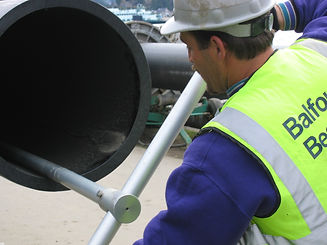
WHY REMOVE THE BEAD?
Eliminate the bead. Eliminate the problem.
High-Density Polyethylene (HDPE) is becoming increasingly popular across industries due to its superior performance compared to legacy materials. Its remarkable flexibility and durability facilitate the removal of both internal and fusion beads, expanding the pipe's utility without affecting it’s pressure rating.
Removing the internal fusion bead will streamline your piping system, optimize flow, and eliminate potential blockage issues in the future.
It is common to remove the interior bead in gravity sewer applications where the slope of the pipe is <2% grade. Removing the internal/external bead is an observed and effective practice in mining operations, horizontal directional drilling, pipeline pigging operations, swagelining, sliplining, duct and conduit work, and dual containment systems.

INSPECTION & MAINTENANCE
For pipeline pigging and other flushing operations, removing the internal bead can provide the necessary clearance for routine maintenance. Removing the bead also better facilitates wheeled inspection cameras.

CONDUIT
For electrical or telecommunications conduit, removing the bead allows internal cable lines to lay flat inside the pipe, reducing wear. This is especially prudent in underground pipelines hosting fiber optic cable.
SLIPLINING &
SWAGELINING
When inserting a smaller diameter carrier pipe into a host pipe, removing the external bead in the carrier pipe (and/or the internal bead in the host pipe) provides a smooth, unimpeded operation.
REDUCE
FLOW RESTRICTION
The internal bead can create a slight restriction in the pipe, potentially reducing flow rate and increasing pressure. In low-grade gravity lines or other applications where a smooth internal surface is required, removing the bead will streamline the interior of the pipe and optimize flow.
PREVENT BLOCKAGES
In disposal or sewer lines with low pressure, the internal bead can entrap debris and sediment, potentially leading to blockages over time. For this reason, bead removal is increasingly adopted in municipal waterworks specifications across the country.
IMPROVED HYGIENE
In water applications, the internal bead can harbor bacteria and biofilm, affecting water quality over time. Removing the bead is often recommended for potable water pipes to maintain water quality and hygiene.
Remove fusion beads with the

R&L's patented BeadTrimmer tooling and machines are specifically designed to remove the interior/exterior fusion bead in thermoplastic pipe material such as HDPE and PVC. Removing the bead does not compromise the integrity of the fused pipe, or affect its pressure rating.
Click below for more information about our HDPE BeadTrimmer series (BT2, BT3, MLBT, UEBT).
